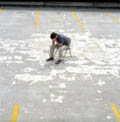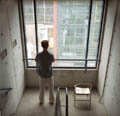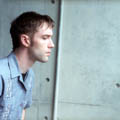| Born in Caracas, Venezuela, Mariliana Arvelo graduated in 2002 from the New England School of Photography, specializing in editorial and photojournalism. Her work has appeared in several international publications and was recently awarded juror's and viewer's choice awards at a group show at MIT. Her work transcends traditional realms of commercial and documentary work, uniting social concern with aesthetic mastery. Her beautifully composed, thoughtful images convey meaning through placement, color, and mood. As stated on her website, "Mariliana’s photography focuses on the beauty, character, and experience of those struggling to cope with adversity."
Featured online are selections from three series: work taken while she resided at Centro Maria, a residence run by Catholic nuns in New York City, environmental portraiture in and around MIT, and a more recent body of work on deafblind people in Boston.
Leslie K. Brown, PRC Curator
Click here for Arvelo's web site
 |
PAST PRESENTATIONS
Click here for more information
about the Northeast Exposure.
|
|
| Centro Maria is a residence for young women in New York run by Catholic nuns from Spain and Latin America. When I moved to New York in 2002, I came to Centro Maria on the recommendation of a friend of my mother, who had stayed there many years ago. My first reaction was to the contrast between the residence and its chaotic environs in the area of midtown Manhattan known as Hell's Kitchen. I was planning to stay just for a few weeks while I looked for an apartment, but over time that changed as I got to know the nuns that lived and worked there. These nuns are full of stories, but are generally very closed with respect to their private lives. They work all day cooking, cleaning, fixing things, doing laundry, and praying. These women sacrifice everything to work for God and to help others, but at times they must cope with feelings of frustration and isolation. At first the nuns weren't willing to let me photograph them. They didn't understand why I could want to take their pictures. But after living there a few months and building closer relationships with them, gradually I was able to take more and more photos. The focus of the project was to take the portraits in key spaces of the house, places where they were most, or places over which they felt a sense of ownership |
|



Click each image for larger version and caption. |

MIT Campus |
| After living at Centro Maria for a year, I got married and moved to live with my husband on the campus of the Massachusetts Institute of Technology, where he is a student. The MIT campus is surrounded by industrial spaces: a mix of buildings from biotech companies, the dot-com boom, and abandoned or repurposed structures from MIT's frenzied research efforts during the World War II era. Today, for most people in this community, these buildings are simply obstructions along one's daily paths. Together, they form an anonymous urban space. I became interested in exploring how one could play with these spaces by shooting staged photos, and reinterpret the purpose and significance of the place where each photo is taken.
   Click each image for larger version and caption.
Click each image for larger version and caption. |

Deaf Blind |
The world presents daily challenges to those who are deaf-blind. The difficulty in communicating with others isolates them, and they face a constant struggle against this separation. My goal through this photo project is to show the rest of the world who these people are, what they are struggling with, and to work toward connecting them with the larger community. Communicating with one who is deaf-blind is a truly amazing experience. Their preferred method of communication depends on when they lost their sight and hearing. One of the most common approaches is sign language, together with the sense of touch. They put their hands against the hands of the person with whom they are talking and they feel each other making hand gestures. It is inspiring to see how much the deaf-blind community has accomplished, given the daily challenges they must overcome.
I started this project photographing Jaimi Lard. She was born completely deaf and with almost no vision. She can read something with large text if she holds it really close to her face. Jaimi is an amazing person who is trying to have a good life. She works at Perkins School for the Blind in the Public Relations department, where her job is to go to schools and different places to talk about her experiences in life. Jaimi loves exercise and food. Every time I see her I learn something new from her. Susan Hajjar and Jaimi opened the doors to this community for me, and now I am photographing more deaf blind people and learning sign language. This project gives a lot of sense to my life.
Perhaps best know for their famous alumna, Helen Keller (who later went to Radcliffe College), the Perkin’s School is located in Watertown, MA.
Click here for the Perkin’s School website.
|
 |



Click each image for larger version and caption. |
|